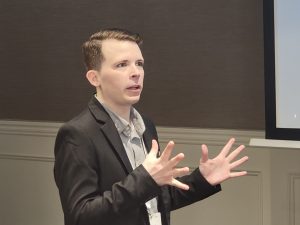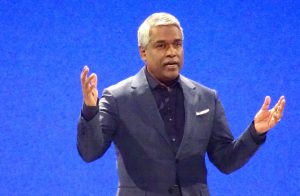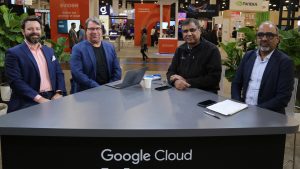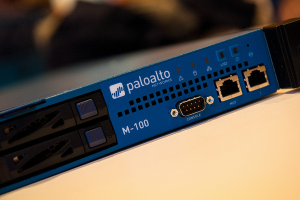OpenStack’s Game: The Enemy’s Gate Is Down
![]() There’s this idea out there that OpenStack, the open source cloud computing platform project started by Rackspace Hosting and NASA and since taken up by over 150 other companies, is out to erode the market positions of proprietary-powered pioneers Amazon Web Services and VMware. But here at the OpenStack conference, I’m hearing that there’s a different game going on: OpenStack is a movement, and Amazon and VMware are already behind the curve.
There’s this idea out there that OpenStack, the open source cloud computing platform project started by Rackspace Hosting and NASA and since taken up by over 150 other companies, is out to erode the market positions of proprietary-powered pioneers Amazon Web Services and VMware. But here at the OpenStack conference, I’m hearing that there’s a different game going on: OpenStack is a movement, and Amazon and VMware are already behind the curve.
At a party this week, I was fortunate enough to grab twenty minutes of Chris Kemp’s time. Kemp, for those who don’t know, boasts a resume that includes stints as NASA CTO, OpenStack co-founder and, currently, CEO of OpenStack service provider Nebula.
Given his history with the platform, Kemp is very much the voice of the OpenStack community, and his passion for the project is immediately apparent. The need for OpenStack goes right back to the moment that Microsoft and Apple launched the personal computer and made mainframes passé.
From that point forward, the IT industry was geared towards expanding the client side of things – Microsoft Windows Server and the entire architecture behind it was really just about supporting a market that was growing ever more complex, not reinventing the wheel.
That’s where VMware comes in. Virtualization enables the more efficient usage of data center resources, but it’s still just running the latest versions of creaky legacy apps that have been updated and updated again for years. Again, useful and supportable and reliable – but not a real game-changer. And that’s not even to mention the costly licenses that can make scaling up an extremely expensive proposition.
And then there’s Amazon Web Services, which Kemp refers to as an evolution, not a revolution. In short, Amazon has an impressive range of services, but it’s a “battleship,” to borrow his term. It has its data centers firmly plunked down, and offers what it offers. If you need more security, or your services have a geographical requirement, or if you just don’t want to pay exponentially more per a gigabyte of cloud storage than you would for the same physical disc, you’re out of luck. Basically, the more an organization scales, the less attractive Amazon Web Services gets.
Both of those, as Kemp and I both hope is clear, have their benefits. But Kemp draws a distinction between “products,” which are created, marketed and sold by one vendor, and a “stack,” which is created by an entire ecosystem of service providers, systems integrators, software engineers, and, yeah, kernel hackers. In his keynote address before the assembled thousand-plus OpenStack developers, customers, partners and prospective users, Kemp proudly declared “The stack is the ecosystem. The ecosystem is the stack.”
That’s absolutely critical to understanding where OpenStack is coming from as it performs the victory lap that goes with the much-heralded Essex platform release. OpenStack, rather than compete with Amazon Web Services and VMware, is enabling service providers to take the core platform and run with it, doing what they do best. For the big guys, like Rackspace and HP, that means a full-fledged public cloud with huge reach and heavy-duty support. For smaller providers, it could mean geographic proximity, managed private clouds, ultra-high security and compliance, or a combination therein, or even rolling their own highly-customized distros of OpenStack (as Piston has done).
But the interoperability of the OpenStack cloud ensures that the entire ecosystem is on even footing. Ten different OpenStack-based service providers may fight over the same customers, but what they all agree about is how these services and workloads should work with each other. And it drives overall price pressure downwards for the cloud itself, as licensing isn’t a concern with OpenStack. The service provider can offer high-margin services without having to inflate the price beyond Amazon Web Services.
It goes deeper than that, too. OpenStack’s underlying architecture is designed to be modular and highly abstracted, beyond even the legacy support that VMware calls for. Take, for example, Morphlabs, a vendor that took the conference as an opportunity to launch an all-SSD, converged infrastructure private cloud solution powered by OpenStack. OpenStack’s modular nature enabled the company to build this rack-mounted “cloud-in-a-box” with 12 terabytes of storage and no SAN, taking the ceiling off the price vs. performance curve, says Morphlabs VP of Corporate Development Yoram Heller.
It’s true that Amazon EC2 remains the gold standard for API compatibility in the cloud. But the nice thing about an open source project like OpenStack is that the community is on top of it. Canonical’s unfortunately-named AWSome (it stands for Any Web Service Over Me, in this week’s winner for most forced acronym) is specifically designed to add a compatibility layer between OpenStack and AWS clouds. OpenStack’s lack of official adoption of the Amazon EC2 API remains controversial, but the benefit of keeping it separate-but-compatible means that the OpenStack community can ensure workload portability without being beholden to a proprietary standard.
What you may not have noticed is any baying for VMware or Amazon Web Services’ blood. That’s because it’s simply not there. Kemp and the community at large see OpenStack as the true next level platform for web-scale, high-performance, built-to-fail cloud applications. There’s no such thing as competition between Amazon Web Services and OpenStack or VMware and OpenStack – they’re playing totally different games.
That’s the optimistic view of where OpenStack stands. But despite Kemp’s bold claims, OpenStack still has plenty of serious market challenges ahead. Come back tomorrow where I give equal time to dark side of the OpenStack conversation.
A message from John Furrier, co-founder of SiliconANGLE:
Your vote of support is important to us and it helps us keep the content FREE.
One click below supports our mission to provide free, deep, and relevant content.
Join our community on YouTube
Join the community that includes more than 15,000 #CubeAlumni experts, including Amazon.com CEO Andy Jassy, Dell Technologies founder and CEO Michael Dell, Intel CEO Pat Gelsinger, and many more luminaries and experts.
THANK YOU













